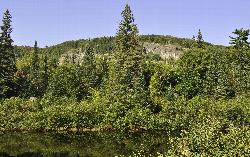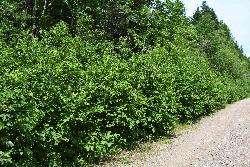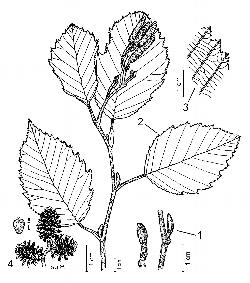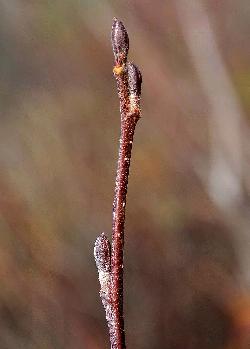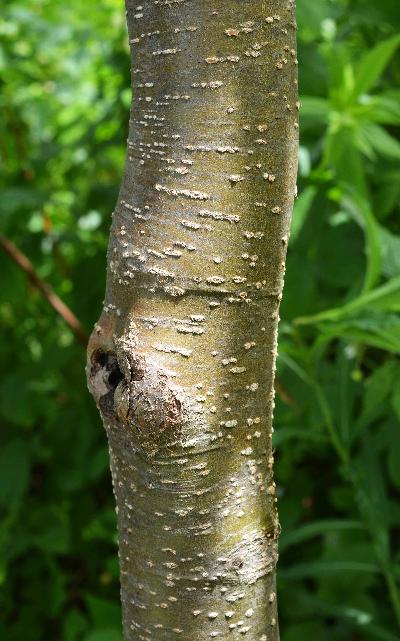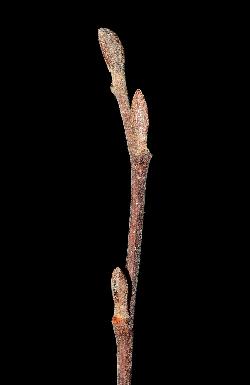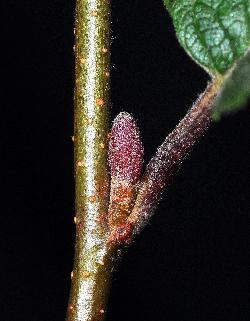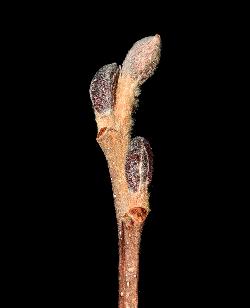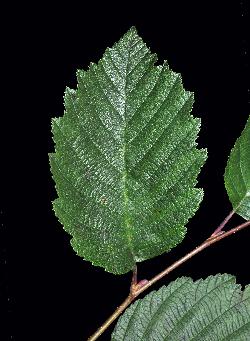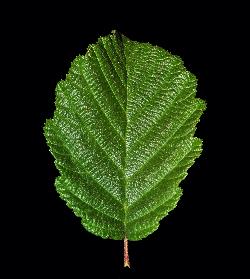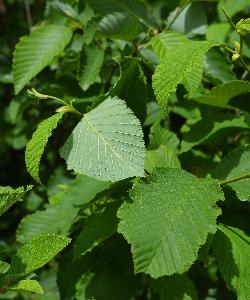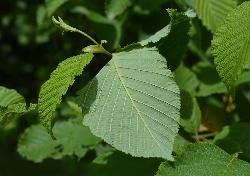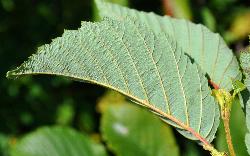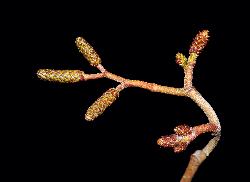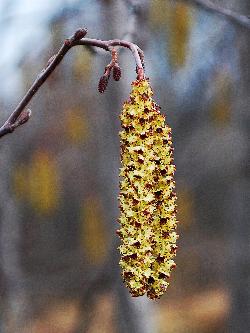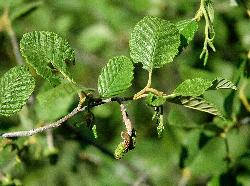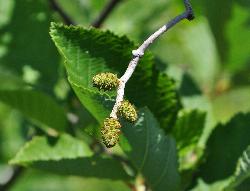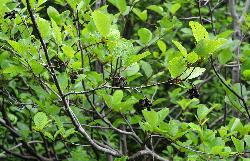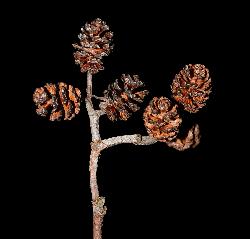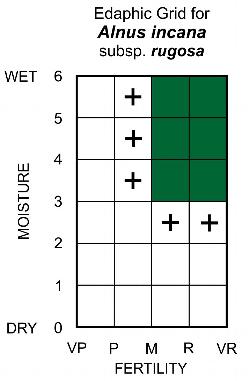Fr: aulne rugueux, aulne hâtif
IA: atushpi, atushpi-kamikuat, uishakashk
Betulaceae - Birch Family
Alnus incana (L.) Moench subsp. rugosa (DuRoi) R.T. Clausen
En: speckled alder, tag alder, swamp alder, hoary alder
Fr: aulne rugueux, aulne blanc rugueux, aulne hâtif, vergne
IA: atushpi-kamikuat, atushpi, uishakashk
Betulaceae (Birch Family)
Note: Numbers provided in square brackets in the text refer to the image presented above; image numbers are displayed to the lower left of each image.
General: A tall multi-stemmed deciduous shrub, 3.5–4 m tall in our region, often forming dense thickets along stream margins [1–2], on seepage slopes, and in wet forest types. Speckled alder is a pioneer species on wet habitats and its root nodules are capable of fixing nitrogen. Alder thickets provide shelter along streams for many small mammals and birds; their small fruit are eaten by a variety of small birds, but their leaves are seldom consumed as browse (Fryer 2011).
Key Features: (numbers 1–4 refer to the illustration [3])
- Buds are stalked, blunt (obtuse), with 2 dull valvate bud scales.
- Leaves are ovate to obovate, with broadly cuneate to rounded bases and shallowly-lobed, coarsely biserrate margins.
- Cross-veins meet between the secondary veins, forming ladder-like connections.
- Fruiting 'cones' are ovoid and sessile or short-stalked, with peduncles less than 5 mm long.
Stems/twigs: Twigs are reddish-brown to purplish-brown with pale lenticels [4]; the bark of older branches is reddish-brown to dark grey with prominent pale lenticels [5]; the conspicuous lenticels are the source of the common name 'speckled' (Soper and Heimburger 1982). Terminal and lateral buds are stalked [6–7], oblong, 3–7 mm long, dull, usually blunt (obtuse) at the tip, but occasionally acute, and with 2 valvate bud scales; the stalks of the buds are 2–4 mm long; bud scales are purplish-brown and leathery. Overwintering twigs are finely hairy to glabrate, while buds are often coated with a dense layer of pale brownish hairs [8]. Leaf scars are hemispherical with what looks like 3 bundle trace scars, but the central scar is actually 2 bundle trace scars that form a small 'v', appearing as one scar [8].
Leaves: Alternate, simple, pinnately-veined, and petiolate; petioles are 1–2 cm long. Leaf blades are firm, broadly elliptic, ovate, or obovate, 4–11 cm long by 3–8 cm wide, dark green and glabrous above [9–11]; the lower surface is paler, glabrous to finely hairy, and often glaucous [12–14]. Leaf bases are broadly tapering (cuneate) to rounded; the apex is blunt to pointed (acute to acuminate); and leaf margins are usually shallowly lobed and coarsely double-serrate (biserrate). There are 10 or more pairs of secondary veins and the small cross-veins (tertiary veins) meet between the secondary veins to form ladder-like connections [15]. This trait is most visible on the lower leaf surface.
Flowers: Unisexual, plants monoecious, with numerous flowers arranged in separate male and female catkins borne on the same shrub and branch. In speckled alder, the male and female catkins are both arranged in terminal over-wintering catkins [16–17] and emerge well before the leaves. The small female (pistillate) overwintering catkins are naked (lacking protective scales), dark red, ovoid to oblong, and occur in clusters of 2–6, borne a short distance behind the larger male catkins. Male (staminate) catkins, in clusters of 2–4, are initially 1–2.5 cm long, then elongate to 2–7 cm when shedding pollen [18–19].
Fruit: Young fruiting catkins are green [20–21], while mature fruiting catkins are persistent, woody, reddish-brown, and cone-like, 1–1.7 cm long by 0.8–1.2 cm wide, sessile or borne on short peduncles, 1–5 mm long [22–24]. The fruits are small 2-winged nutlets that are borne on the scales of the fruiting catkins; the lateral wings of the fruit are narrower than the nutlet.
Ecology and Habitat: Speckled alder is most conspicuous on fluvial floodplains that are seasonally inundated, where it forms alder swamps and dense alder thickets; it can also occupy canopy gaps in forested slopes on somewhat wet to wet seepage soils. Speckled alder never reaches full crown closure in this habitat due to repeated natural disturbance. Differences in moisture regime, frequency of flooding, nutrient levels, and soil aeration create a variety of diverse vegetation types that occur in the transition from lower forested slopes to river margins. Speckled alder also occurs in low abundance in black spruce forests in transition to peatlands.
Edaphic Grid: See image [25]: the Edaphic Grid for Alnus incana subsp. rugosa.
Forest Types: Speckled alder is the dominant species in the following vegetation types:
- Alneto-Piceetum (Alder-Black Spruce Swamp Association)
- Alnetum dryopteretosum (Dryopteris-Alder-Black Spruce Swamp Subassociation)
- Alnetum solidagetosum (Solidago-Alder-Black Spruce Swamp Subassociation)
- Alnetum typicum (Moist Alder-Black Spruce Swamp Subassociation)
- Alnetum rugosae (Alder Swamp Association)
- Alnetum caricetosum (Carex-Alder Swamp Subassociation)
- Alnetum lycopodietosum (Lycopodium-Alder Swamp Subassociation)
There is also a rare Larix-Alder Type (Damman 1967) that occurs on marine clays with high lime content near Point au Mal, north of Stephenville.
Peatland Types: Speckled alder occurs in the following peatland associations (Pollett & Bridgewater 1973):
- Calamagrostio-Sphagnetum fusci (Fen Hummock Association)
- Scirpo-Sphagnetum papillosi (Peatland Flark Association)
- Campylietum stellati (Rich Fen Association)
Speckled alder occurs sporadically as a prostrate growth form in mesotrophic bogs and fen hummock. In richer fens, it is more frequent and abundant, and grows as a low shrub. In combination with Thalictrum pubescens, Rosa nitida, Eriophorum angustifolium, Carex buxbaumii, and Sphagnum papillosum, it forms the Sphagnetosum Subassociation of the Campylietum stellati Rich Fen Association, which occurs primarily in central and western Newfoundland.
Succession: Due to its ability to fix nitrogen, speckled alder is a pioneer species that is particularly well-adapted to occupying wet sites that are frequently disturbed. However, it is rarely found on the dry sites occupied by mountain alder and does not appear to occupy severely exposed conditions above treeline. Speckled alder is shade-intolerant, but does persist in low abundance in the partial shade of black spruce forests on bog margins. Speckled alder also has the ability to invade productive forests on seepage slopes and create regeneration problems after fire or logging. This is primarily a problem in central Newfoundland, while mountain maple causes similar silvicultural problems in western Newfoundland.
Distribution: Speckled alder is a north-temperate to boreal species that occurs throughout central and western Newfoundland, but is absent from the Great Northern and Avalon Peninsulas. It is also absent from most of northern Labrador. On mainland Canada, its range extends from Nova Scotia and Québec west to Saskatchewan. In the United States, it extends west from Maine to eastern North Dakota and south to West Virginia and Kentucky (Furlow 1997).
Similar Species: Mountain alder (Alnus alnobetula (Ehrh.) K.Koch subsp. crispa (Aiton) Raup) is similar to speckled alder, but mountain alder has sessile pointed (acute) buds with several shiny imbricate scales; biserrulate margins that are rarely lobed, cross veins between the secondary veins that are not continuous; and long-stalked woody fruiting 'cones' on peduncles 1–5 cm long. Also, female catkins of mountain alder are enclosed within overwintering buds.


